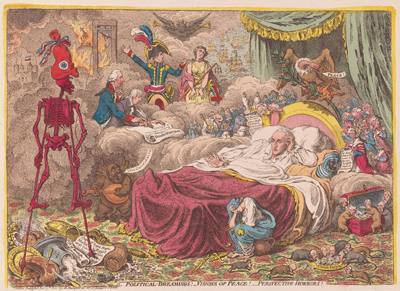Political Dreamings! Visions of Peace! Perspective Horrors!
This is one of those wonderfully detailed and inventive prints that only Gillray could have created. It purports to show the dream, or more accurately, nightmare vision of William Windham, the former Secretary of War under William Pitt.

© Beinecke Rare Book and Manuscript Library, Yale University
The impetus for the print was the debate that followed the signing of the Preliminary Treaty of Amiens on October 1st 1801 which put a temporary end to the war between Britain and France raging in varying forms and with varying participants since 1793.
Windham had been a staunch supporter of the war against revolutionary France from its inception until Pitt's resignation in February 1801 over the issue of Catholic Emancipation. Like others in the Pitt administration at the time, Windham resigned in protest along with the Prime Minister. But unlike Pitt who had pledged to support the new Addington ministry in its quest for peace with France, Windham maintained a vigorous opposition to the peace and portrayed what he deemed to be its disastrous consequences in vividly detailed speeches both inside and outside Parliament.
As reported in the London Oracle And Daily Advertiser on October 30 p. 2, for instance, here is how Windham reacted to the general joy expressed by members of the House of Commons over the preliminary treaty:
I am very far from seeing any cause for joy. The advantages, proposed from it appear to me transient, precarious, delusive, and never to be realized. I will not put on my wedding clothes till I know whether I am going to a marriage or funeral. The Peace is to me me that knell which calls to the grave-yard, and the demonstrations of joy as those lights that surround the sepulchre. Looking to the final balance of accounts, I attest, with all the solemnity of a dying declaration, that in concluding this Peace, Ministers have, I fear, in an unfortunate and fatal hour, signed the DEATH-WARRANT of their country.
Like Windham, Gillray had a knack for imagining the worst, especially when it came to portraying French intentions once they were allowed to pursue them. But by casting the print as a nightmare, Gillray could give free rein to his apocalyptic imagination while, at the same time, disclaiming any responsibility for the views expressed.
In the clouds to Windham's right, we see Hawkesbury, the Secretary of State for Foreign Affairs, guided by Pitt, signing the treaty labeled "Death Warrant." And as if called forth by that fatal act, a blood red figure of death appears before the dreaming Windham wearing a Revolutionary bonnet rouge and spearing the symbols of British values and victories. Those include the mitre and mace of the British church and state, the roast beef and ale of popular culture, and a "List of British Conquests" during the war which would now be lost by the terms of the agreement.
Above and beside Windham's bed we get a further view of what this treaty means. A vulture appears (instead of a dove) perched on an olive branch and mauling a helpless rabbit even while it croaks "Peace!" On either side of Windham's bed, we see two lines of decapitated figures representing the past and future victims of French Justice, the guillotine. On the left, we see Louis XVI, his family, and his political and religious allies. He holds a placard with the plea: "Oh! Remember Our Cause! poor Ghosts of French Ladies and Gentlemen." On the right, we have a similar array of headless figures with the the grim warning of what England can expect: "Ah! See what is to become of Us poor English Men of Consequence." At the foot of the bed, a tattered figure of Justice with broken sword and shattered scales sits upon a sordid chamber pot in despair.
At the top/center of the print, we see the next and most significant consequence of this treaty: Britannia herself, hand-cuffed and weeping with a broken trident and dented shield by her side being led with a noose around her neck to the bloody guillotine by Napoleon Buonaparte. Meanwhile French ships arrive at the English coast, the French flag flies over the Tower of London, and St Paul's cathedral is going up in flames.
The only British beneficiaries in this nightmare scenario are pathetic Whig rats who are feeding on the proverbial cheese parings and candle ends in the lower right hand corner. Gillray portrays all the usual suspects, including Sheridan, Bedford, Norfolk, and Erskine at the box of candle ends, and Nicholls, Hanger, Burdett, and others at the plate of cheese parings. A demon Fox with bat wings and forked tail is set apart singing the popular revolutionary theme song, "Ça ira" the perfect accompaniment to Windham's "Perspective Horrors."
Gillray's attitude towards all this is deeply ambiguous. Is he satirizing a dangerous and potentially fatal treaty or the rejected and extreme hallucinations of a former minister?
Sources and Reading
- Commentary from the British Museum on Political Dreamings! Visions of Peace! Perspective Horrors!.
- Christiane Banerji and Diana Donald, Gillray Observed, 1999, Ch. 12
- Draper Hill, Mr. Gillray The Caricaturist, 1965, p. 105, 126 Pl. 93
- "War of the Second Coalition," Wikipedia
- "Treaty of Amiens," Wikipedia
- "Robert Jenkinson, 2nd Earl of Liverpool," Wikipedia
- "Napoleon," Wikipedia
- "William Pitt the Younger," Wikipedia
- "William Windham," Wikipedia
- Thomas Wright and R.H. Evans, Historical and Descriptive Account of the Caricatures of James Gillray #262
- Thomas Wright and Joseph Grego, The Works of James Gillray, the Caricaturist; With the History of His Life and Times, p. 278
Comments & Corrections
NOTE: Comments and/or corrections are always appreciated. To make that easier, I have included a form below that you can use. I promise never to share any of the info provided without your express permission.